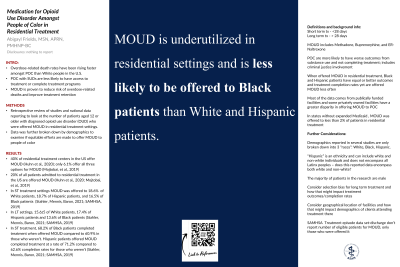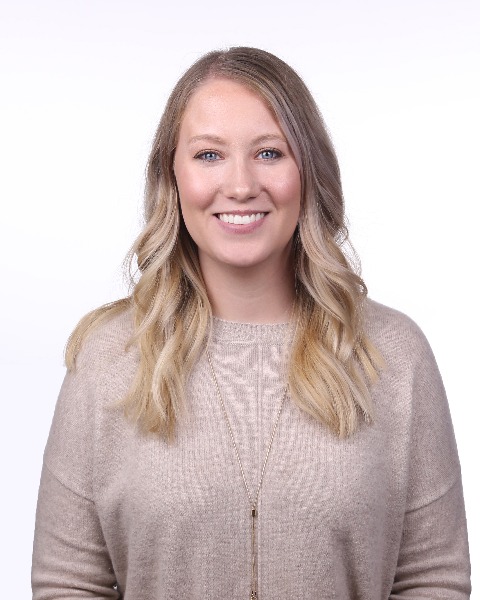Back

Introduction: Overdose-related deaths affecting people of color have been increasing at faster rates than for White Americans. People of color are also less likely to have access to treatment or complete treatment programs. Medication for Opioid Use Disorder (MOUD) is known to significantly reduce risk of overdose-related death and increase treatment retention. Clinical observations suggest that MOUD is underutilized in residential treatment settings and offered less often to people of color.
Methods: Retrospective review of cross-sectional studies and national data reporting to look at the number of patients aged 12 or older with diagnosed opioid use disorder (OUD) who were offered MOUD in residential treatment settings. Data was further broken down by demographics to examine if equitable efforts are made to offer MOUD to people of color. Demographic information is limited thus people of color were limited to Black and Hispanic peoples for the purpose of this study. Short term (ST) residential programs lasting less than 31 days and long term (LT) residential programs lasting more than 31 days were examined separately. Three FDA approved medications were identified as MOUD: buprenorphine (with or without naloxone), methadone, and extended-release naltrexone.
Results: Twenty percent of patients with OUD in residential treatment facilities were offered MOUD in 2017. Only 40 percent of residential treatment facilities offered MOUD at all (Huhn et al., 2020). Hispanic patients are offered MOUD at the same rate as White patients in ST settings but more than White patients in LT settings; however, Black patients were offered MOUD significantly less in both treatment settings (Stahler, Mennis, Baron, 2021). From 2015 to 2017, eighteen percent of all patients in both ST and LT treatment were offered MOUD. In the same study, MOUD was offered to 18.6 percent of White patients, 18.7 percent of Hispanic patients, and 16.5 percent of Black patients in ST settings. In LT settings, 15.6 percent of White patients, 13.6 percent of Black patients, and 17.4 percent of Hispanic patients were offered MOUD. In ST treatment settings, 68.2 percent of Black patients completed treatment when offered MOUD compared to 60.9 percent in those not offered MOUD. Hispanic patients offered MOUD completed treatment at a rate of 71.2 percent compared to 62.6 percent completion rates for those not offered MOUD (Stahler, Mennis, Baron, 2021; SAMHSA, 2019).
Conclusion: MOUD is offered to a small percentage of patients in residential treatment settings in the United States. An even smaller number of Black patients are offered MOUD. Hispanic patients are offered MOUD at about the same rate as White patients in ST settings and higher rates in LT settings. Data indicates that offering MOUD to Black and Hispanic patients increase rates of program retention and completion. By providing MOUD at such low rates it puts patients of color at higher risk for not completing the program, relapse, and overdose following discharge. By not providing “gold standard” care to all patients seeking treatment, health equity has been compromised.
References: Huhn, A.S., Hobelmann, J. G., Strickland, J.C., Oyler, G. A., Bergeria, C.L., Umbricht, A., Dunn, K.E., 2020. Differences in availability and use of medications for opioid use disorder in residential treatment settings in the united states.JAMA Netw. Open 3, e1920843. DOI: 10.1001/jamanetworkopen.2019.20843
SAMHSA, 2019. Treatment episode data set-discharge (TEDS-D), 2015-2017. Substance Abse and Mental Health Services Administration, Rockville, MD. Accessed January 18, 2022. https://datafiles.samhsa.gov/study-series/treatment-episode-data-set-discharges-teds-d-nid13520
Stahler, G., Mennis, J., Baron, D., 2021. Racial/ethnic disparities in the use of medications for opioid use disorder (MOUD) and their effects on residential drug treatment outcomes in the US. Drug and Alcohol Dependence, 226. https://doi.org/10.1016/j.drugalcdep.2021.108849
(43) Medication for Opioid Use Disorder Amongst People of Color in Residential Treatment
Friday, April 1, 2022
11:30 AM – 1:00 PM ET
Location: Great Hall Foyer, Third Floor


Abigayl Frields, MSN, APRN, FNP-C, PMHNP-BC
Nurse Practitioner
Carle Addiction Recovery Center, Illinois
Presenter(s)
Introduction: Overdose-related deaths affecting people of color have been increasing at faster rates than for White Americans. People of color are also less likely to have access to treatment or complete treatment programs. Medication for Opioid Use Disorder (MOUD) is known to significantly reduce risk of overdose-related death and increase treatment retention. Clinical observations suggest that MOUD is underutilized in residential treatment settings and offered less often to people of color.
Methods: Retrospective review of cross-sectional studies and national data reporting to look at the number of patients aged 12 or older with diagnosed opioid use disorder (OUD) who were offered MOUD in residential treatment settings. Data was further broken down by demographics to examine if equitable efforts are made to offer MOUD to people of color. Demographic information is limited thus people of color were limited to Black and Hispanic peoples for the purpose of this study. Short term (ST) residential programs lasting less than 31 days and long term (LT) residential programs lasting more than 31 days were examined separately. Three FDA approved medications were identified as MOUD: buprenorphine (with or without naloxone), methadone, and extended-release naltrexone.
Results: Twenty percent of patients with OUD in residential treatment facilities were offered MOUD in 2017. Only 40 percent of residential treatment facilities offered MOUD at all (Huhn et al., 2020). Hispanic patients are offered MOUD at the same rate as White patients in ST settings but more than White patients in LT settings; however, Black patients were offered MOUD significantly less in both treatment settings (Stahler, Mennis, Baron, 2021). From 2015 to 2017, eighteen percent of all patients in both ST and LT treatment were offered MOUD. In the same study, MOUD was offered to 18.6 percent of White patients, 18.7 percent of Hispanic patients, and 16.5 percent of Black patients in ST settings. In LT settings, 15.6 percent of White patients, 13.6 percent of Black patients, and 17.4 percent of Hispanic patients were offered MOUD. In ST treatment settings, 68.2 percent of Black patients completed treatment when offered MOUD compared to 60.9 percent in those not offered MOUD. Hispanic patients offered MOUD completed treatment at a rate of 71.2 percent compared to 62.6 percent completion rates for those not offered MOUD (Stahler, Mennis, Baron, 2021; SAMHSA, 2019).
Conclusion: MOUD is offered to a small percentage of patients in residential treatment settings in the United States. An even smaller number of Black patients are offered MOUD. Hispanic patients are offered MOUD at about the same rate as White patients in ST settings and higher rates in LT settings. Data indicates that offering MOUD to Black and Hispanic patients increase rates of program retention and completion. By providing MOUD at such low rates it puts patients of color at higher risk for not completing the program, relapse, and overdose following discharge. By not providing “gold standard” care to all patients seeking treatment, health equity has been compromised.
References: Huhn, A.S., Hobelmann, J. G., Strickland, J.C., Oyler, G. A., Bergeria, C.L., Umbricht, A., Dunn, K.E., 2020. Differences in availability and use of medications for opioid use disorder in residential treatment settings in the united states.JAMA Netw. Open 3, e1920843. DOI: 10.1001/jamanetworkopen.2019.20843
SAMHSA, 2019. Treatment episode data set-discharge (TEDS-D), 2015-2017. Substance Abse and Mental Health Services Administration, Rockville, MD. Accessed January 18, 2022. https://datafiles.samhsa.gov/study-series/treatment-episode-data-set-discharges-teds-d-nid13520
Stahler, G., Mennis, J., Baron, D., 2021. Racial/ethnic disparities in the use of medications for opioid use disorder (MOUD) and their effects on residential drug treatment outcomes in the US. Drug and Alcohol Dependence, 226. https://doi.org/10.1016/j.drugalcdep.2021.108849
